
Pope Gregory XV, born Alessandro Ludovisi, was the head of the Catholic Church and ruler of the Papal States from 9 February 1621 until his death in 1623. He is notable for founding the Congregation for the Propagation of the Faith, an organization tasked with overseeing the spread of Catholicism and missionary work. Gregory XV was also responsible for the canonization of Saints Ignatius of Loyola, Francis Xavier, Teresa of Ávila, and Philip Neri, which solidified his commitment to the Counter-Reformation.

Pope Urban VIII, born Maffeo Vincenzo Barberini, was head of the Catholic Church and ruler of the Papal States from 6 August 1623 to his death, in July 1644. As pope, he expanded the papal territory by force of arms and advantageous politicking, and was also a prominent patron of the arts, commissioning works from artists like Bernini and a reformer of Church missions. His papacy also covered 21 years of the Thirty Years' War.
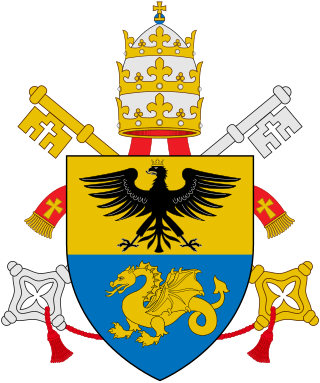
Pope Paul V, born Camillo Borghese, was head of the Catholic Church and ruler of the Papal States from 16 May 1605 to his death, in January 1621. In 1611, he honored Galileo Galilei as a member of the papal Accademia dei Lincei and supported his discoveries. In 1616, Pope Paul V instructed Cardinal Robert Bellarmine to inform Galileo that the Copernican theory could not be taught as fact, but Bellarmine's certificate allowed Galileo to continue his studies in search for evidence and use the geocentric model as a theoretical device. That same year Paul V assured Galileo that he was safe from persecution so long as he, the Pope, should live. Bellarmine's certificate was used by Galileo for his defense at the trial of 1633.

Francesco Barberini was an Italian Catholic Cardinal. The nephew of Pope Urban VIII, he benefited immensely from the nepotism practiced by his uncle. He was given various roles within the Vatican administration but his personal cultural interests, particularly in literature and the arts, meant that he became a highly significant patron. His secretary was the antiquarian Cassiano dal Pozzo who was also a discerning patron of the arts. Francesco was the elder brother of Cardinal Antonio Barberini and Taddeo Barberini who became Prince of Palestrina.

Ippolito Aldobrandini was a Catholic Cardinal. Pope Clement VIII, whose birth name was also Ippolito Aldobrandini, was his great-uncle.

Pietro Aldobrandini was an Italian cardinal and patron of the arts.

A cardinal-nephew was a cardinal elevated by a pope who was that cardinal's relative. The practice of creating cardinal-nephews originated in the Middle Ages, and reached its apex during the 16th and 17th centuries. The last cardinal-nephew was named in 1689 and the practice was abolished in 1692. The word nepotism originally referred specifically to this practice, when it appeared in the English language about 1669. From the middle of the Avignon Papacy (1309–1377) until Pope Innocent XII's anti-nepotism bull, Romanum decet pontificem (1692), a pope without a cardinal-nephew was the exception to the rule. Every Renaissance pope who created cardinals appointed a relative to the College of Cardinals, and the nephew was the most common choice, although one of Alexander VI's creations was his own son.

A crown-cardinal was a cardinal protector of a Roman Catholic nation, nominated or funded by a Catholic monarch to serve as their representative within the College of Cardinals and, on occasion, to exercise the right claimed by some monarchs to veto a candidate for election to the papacy. More generally, the term may refer to any cardinal significant as a secular statesman or elevated at the request of a monarch.
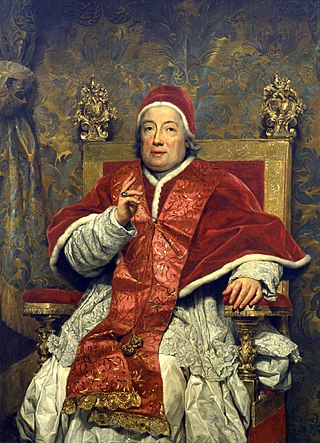
The 1758 papal conclave, convoked after the death of Pope Benedict XIV, elected Cardinal Carlo Rezzonico of Venice, who took the name Clement XIII.
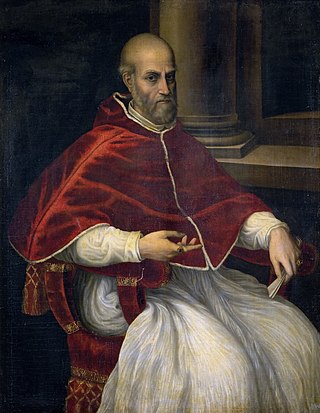
The April 1555 papal conclave was convoked after the death of Pope Julius III. Cardinals at the conclave generally grouped themselves into three major factions, according to their alignment with the French House of Valois, the Hapsburgs, or Italian states that remained independent of both major Catholic powers. After preparing a conclave capitulation that compelled whichever cardinal was elected pope to maintain neutrality in European wars, cardinals from the Holy Roman Empire joined in supporting the French faction's candidate, Cardinal Marcello Cervini. Cervini was elected Julius's successor, and chose to maintain his baptismal (birth) name as his papal name, becoming consecrated as Marcellus II.
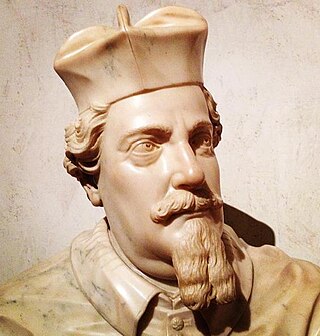
Giulio Gabrielli was an Italian Catholic cardinal. He is sometimes referred to as Giulio Gabrielli the Elder to distinguish him from Giulio Gabrielli the Younger.
Giambattista Altieri or Giovanni Battista Altieri was an Italian Catholic Cardinal.

Luigi Capponi was an Italian Catholic cardinal who became archbishop of Ravenna.

Giovanni Doria, called Giannettino, the son of Giovanni Andrea Doria, 6th Prince of Melfi, and Princess Zenobia Doria del Carretto, 5th Princess of Melfi.
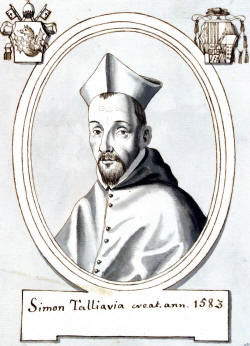
Simeone Tagliavia d'Aragonia (1550–1604) was a Sicilian cardinal and bishop.
Lorenzo Raggi was an Italian Catholic Cardinal.
Alessandro Cesarini, iuniore was a Roman Catholic prelate who served as Cardinal-Deacon of Sant'Eustachio (1638–1644), Cardinal-Deacon of Santa Maria in Cosmedin (1637–1638), Bishop of Viterbo e Tuscania (1636–1638), Cardinal-Deacon of Santi Cosma e Damiano (1632–1637), and Cardinal-Deacon of Santa Maria in Domnica (1627–1632).

Pietro Campori was an Italian cardinal of the Catholic Church and Bishop of Cremona. He was friends with Scipione Borghese, the nephew of Pope Paul V, and was twice a candidate for election to the papacy, in the conclaves of 1621 and 1623.
Camillo Caetani (Gaetano) was an Italian aristocrat and Papal diplomat in several European capitals during the early Counterreformation.
Francesco Sacrati was a Roman Catholic prelate who served as Archbishop of Cesena (1622–1623), Cardinal-Priest of San Matteo in Merulana (1621–1623), and Titular Archbishop of Damascus (1612–1622).














